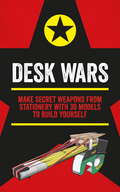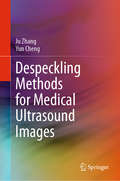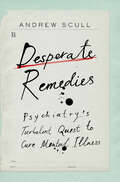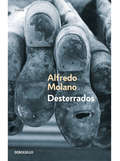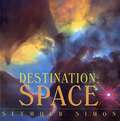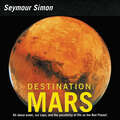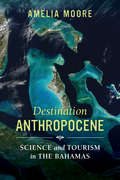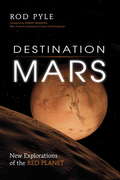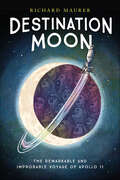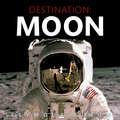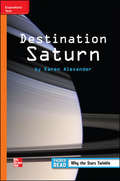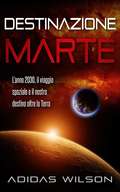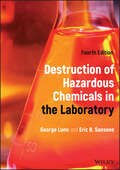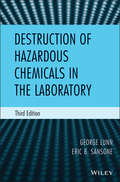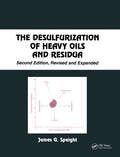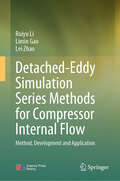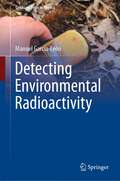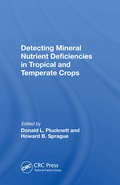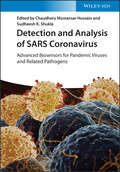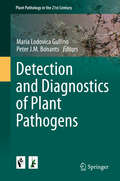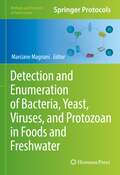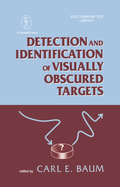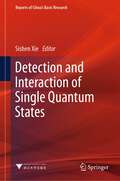- Table View
- List View
Desk Wars: Make secret weapons from stationery with 30 models to build yourself (Mini Weapons of Mass Destruction)
by John Austin'Cubicle farms are full of enemy combatants begging to be taken out.' WIREDAchieve clandestine ends practically and inexpensively with Desk Wars - perfect for do-it-yourself spy enthusiasts. Follow fully illustrated step-by-step instructions to build 30 miniature secret weapons and surveillance tools from stationery, transforming common household items into uncommon gadgets and sidearms.Assert dominion over the desktop with these cunning contraptions:>>> Paper-Dart Watch>>> Pen Blowgun>>> Mint-Tin Catapult>>> Rubber-Band Derringer>>> Toothpaste Periscope>>> Bionic Ear>>> Cotton Bud .38 Special>>> Paper Throwing Star>>> 44 marker magnum>>> And more!
Despeckling Methods for Medical Ultrasound Images
by Ju Zhang Yun ChengBased upon the research they have conducted over the past decade in the field of denoising processes for medical ultrasonic imaging, in this book, the authors systematically present despeckling methods for medical ultrasonic images. Firstly, the respective methods are reviewed and divided into five categories. Secondly, after introducing some basic mathematical tools such as wavelet and shearlet transforms, the authors highlight five recently developed despeckling methods for medical ultrasonic images. In turn, simulations and experiments for clinical ultrasonic images are presented for each method, and comparison studies with other well-known existing methods are conducted, showing the effectiveness and superiority of the new methods. Students and researchers in the field of signal and image processing, as well as medical professionals whose work involves ultrasonic diagnosis, will greatly benefit from this book. Familiarizing them with the state of the art in despeckling methods for medical ultrasonic images, it offers a useful reference guide for their study and research work.
Desperate Remedies: Psychiatry’s Turbulent Quest to Cure Mental Illness
by Andrew ScullA sweeping history of American psychiatry—from prisons to hospitals to the lab to the analyst’s couch—by the award-winning author of Madness in Civilization. For more than two hundred years, disturbances of the mind—the sorts of things that were once called “madness”—have been studied and treated by the medical profession. Mental illness, some insist, is a disease like any other, whose origins can be identified and from which one can be cured. But is this true? In this masterful account of America’s quest to understand and treat everything from anxiety to psychosis, one of the most provocative thinkers writing about psychiatry today sheds light on its tumultuous past. Desperate Remedies brings together a galaxy of mind doctors working in and out of institutional settings: psychologists and psychoanalysts, neuroscientists, and cognitive behavioral therapists, social reformers and advocates of mental hygiene, as well as patients and their families desperate for relief. Andrew Scull begins with the birth of the asylum in the reformist zeal of the 1830s and carries us through to the latest drug trials and genetic studies. He carefully reconstructs the rise and fall of state-run mental hospitals to explain why so many of the mentally ill are now on the street and why so many of those whose bodies were experimented on were women. In his compelling closing chapters, he reveals how drug companies expanded their reach to treat a growing catalog of ills, leading to an epidemic of over-prescribing while deliberately concealing debilitating side effects. Carefully researched and compulsively readable, Desperate Remedies is a definitive account of America’s long battle with mental illness that challenges us to rethink our deepest assumptions about who we are and how we think and feel.
Desterrados
by Bravo Alfredo Molano«Cuando mataron a Jaime Garzón admití que no podía regresar pronto, conseguí una mesa de trabajo grande, alé la pluma y comencé a escribir este libro. Al terminarlo comprendí agachando la cabeza en señal de profundo respeto que el drama de mi exilio, a pesar de sus dolores, es un pálido reflejo de la auténtica tragedia que viven a diario millones de colombianos desterrados, exiliados en su propio país. Creo, con ellos, que sólo un acuerdo político profundo permitirá echar las bases de una verdadera democracia; la guerra no tendría resultado distinto a la dictadura de los vencedores».Alfredo Molano
Destination: Space
by Seymour SimonExplains new discoveries about the universe made possible by the Hubble Telescope.
Destination: Revised Edition
by Seymour SimonAward-winning science writer Seymour Simon explores the Red Planet through fascinating facts and amazing full-color photographs. Readers will learn about the recent discovery of water, the Valles Marineris—the biggest valley on Mars—the ice caps, recent expeditions, and more. This nonfiction picture book is an excellent choice to share during homeschooling, in particular for children ages 6 to 8. It’s a fun way to learn to read and as a supplement for activity books for children.This updated edition includes:author’s notestunning full-color photographsglossaryindexwebsites and additional reading sourcesSupports the Common Core Learning Standards, Next Generation Science Standards and the Science, Technology, Engineering, and Math (STEM) standards.
Destination Anthropocene: Science and Tourism in The Bahamas (Critical Environments: Nature, Science, and Politics #7)
by Amelia MooreDestination Anthropocene documents the emergence of new travel imaginaries forged at the intersection of the natural sciences and the tourism industry in a Caribbean archipelago. Known to travelers as a paradise of sun, sand, and sea, The Bahamas is rebranding itself in response to the rising threat of global environmental change, including climate change. In her imaginative new book, Amelia Moore explores an experimental form of tourism developed in the name of sustainability, one that is slowly changing the way both tourists and Bahamians come to know themselves and relate to island worlds.
Destination Mars
by Rod Pyle Robert ManningIn the next decade, NASA, by itself and in collaboration with the European Space Agency, is planning a minimum of four separate missions to Mars. Clearly, exciting times are ahead for Mars exploration. This is an insider's look into the amazing projects now being developed here and abroad to visit the legendary red planet. <P><P> Drawing on his contacts at NASA and the Jet Propulsion Laboratory, the author provides stunning insights into the history of Mars exploration and the difficulties and dangers of traveling there. After an entertaining survey of the human fascination with Mars over the centuries, the author offers an introduction to the geography, geology, and water processes of the planet. He then briefly describes the many successful missions by NASA and others to that distant world. But failure and frustration also get their due. <P><P>As the author makes clear, going to Mars is not, and never will be, easy. Later in the book, he describes in detail what each upcoming mission will involve. In the second half of the book, he offers the reader a glimpse inside the world of Earth-based "Mars analogs," places on Earth where scientists are conducting research in hostile environments that are eerily "Martian." <P><P>Finally, he constructs a probable scenario of a crewed expedition to Mars, so that readers can see how earlier robotic missions and human Earth simulations will fit together. All this is punctuated by numerous firsthand interviews with some of the finest Mars explorers of our day, including Stephen Squyres (Mars Exploration Rover), Bruce Murray (former director of the Jet Propulsion Laboratory), and Peter Smith (chief of the Mars Phoenix Lander and the upcoming OSIRIS-REx missions). <P><P>These stellar individuals give us an insider's view of the difficulties and rewards of roaming the red planet. The author's infectious enthusiasm and firsthand knowledge of the international space industry combine to make a uniquely appealing and accessible book about Mars.From the Trade Paperback edition.
Destination Moon: The Remarkable and Improbable Voyage of Apollo 11
by Richard MaurerThe history of NASA's Apollo program from Earth orbital missions to lunar landings in a propulsive nonfiction narrative.Only now, it is becoming clear how exceptional and unrepeatable Apollo was. At its height, it employed almost half a million people, many working seven days a week and each determined that “it will not fail because of me.”Beginning with fighter pilots in World War II, Maurer traces the origins of the Apollo program to a few exceptional soldiers, a Nazi engineer, and a young eager man who would become president.Packed with adventure, new stories about familiar people, and undeniable danger, Destination Moon takes an unflinching look at a tumultuous time in American history, told expertly by nonfiction author Richard Maurer.
Destination: Moon
by Seymour SimonAn out-of-this-world exploration of the 1969 Moon landing from children’s science expert Seymour Simon! This nonfiction picture book is an excellent choice to share during homeschooling, in particular for children ages 6 to 8. It’s a fun way to learn to read and as a supplement for activity books for children.In July of 1969, NASA sent the Apollo 11 spacecraft to the Moon. Inside were three people: Neil Armstrong, Buzz Aldrin, and Michael Collins. They went into lunar orbit a few days later. More than a hundred hours after launch, the word came back: “The Eagle has landed!”In this exciting account of the famous 1969 Moon landing, award-winning science writer Seymour Simon tells the story of the Space Race between the US and the Soviet Union; recalls how families across the world sat captivated in front of their TVs to witness humankind’s first steps beyond Earth; and explains much of the science and technology that got our astronauts to the Moon on that remarkable day.Perfect for young scholars’ school reports, Destination: Moon features clear text, vibrantly colored pages, engaging sidebars, and stunning full-color photographs. This book includes an author's note, a glossary, a timeline, and an index and supports the Common Core State Standards.
Destination Saturn (Reading Wonders #Approaching Level, Grade 3)
by Karen AlexanderNIMAC-sourced textbook
Destinations in Science 5
by David C. Brummett Karen K. Lind Charles R. Barman Michael A. Dispezio Karen L. OstlundThis book tries to introduce its readers to an exciting way of thinking about their world, discover that science is everywhere and about the real places one can find to study science like the airport, mountains and some neighbourhood destinations.
Destinazione Marte - L’anno 2030, il viaggio spaziale e il nostro destino oltre la Terra
by Adidas WilsonOggi tutti sembrano interessarsi a Marte. La NASA progetta l’invio di esseri umani su Marte per il 2030, mentre la SpaceX vuole farlo prima, nel 2024. Marte è un argomento ricorrente a Hollywood. Ci sono film, come The Martian e Life, che ipotizzano su come potrebbe essere la vita sul pianeta rosso. Tuttavia, nessuno di questi film sembra affrontare il problema fondamentale: come faranno gli esseri umani a vivere su Marte nel lungo periodo? L’atmosfera di Marte è composta, principalmente, di monossido di carbonio e la sua superficie è troppo fredda per la vita umana. La gravità è pari al 38% di quella terrestre. Di conseguenza, resta la questione di come un essere umano possa sopravvivere in un ambiente simile. Andare su Marte è facile, poiché il viaggio richiede soltanto 260 giorni quando i due pianeti sono più vicini l’uno all’altro. Dopo essere arrivati, la difficoltà è atterrare sulla superficie. Quale sistema di atterraggio è più sicuro per astronauti e coloni? Nel 2007, gli scienziati hanno proposto quattro sistemi di atterraggio: il Legged Standing System, lo Sky-Crane Landing System, l’Airbag Landing System e infine il Touchdown Sensing. Al 2017, gli scienziati hanno trovato altri metodi di atterraggio, tra cui tuffarsi nell’atmosfera marziana e costeggiare più da vicino la superficie. La NASA sta già pensando al tipo di abitazioni che aiuteranno i coloni a sopravvivere su Marte. Nel 2016, sei aziende hanno iniziato a progettare prototipi di possibili habitat. Tutti questi prototipi sono probabilmente simili sotto molti aspetti – dovrebbero essere autosufficienti, in grado di sostenere la vita per lunghi periodi senza aiuto dalla Terra ed essere a tenuta stagna per protezione dalla sottile atmosfera di Marte.
Destiny or Chance Revisited
by Stuart Ross TaylorThis exciting tour of our Universe explores our current knowledge of exoplanets and the search for another Earth-like planet. Beginning with the basic concepts of planet formation and the composition of the Universe, Stuart Ross Taylor summarises our knowledge of exoplanets, how they compare with our planets and why some stars have better habitable zones. Further sections provide a detailed study of our Solar System, as a basis for understanding exoplanetary systems, and a detailed study of the Earth as our only current example of a habitable planet. The book concludes with a philosophical and historical discussion of topics surrounding planets and the development of life, including why our chances of finding aliens on exoplanets is very low. This is an engaging and informative read for anyone interested in planetary formation and the exploration of our Universe.
Destruction of Hazardous Chemicals in the Laboratory
by George Lunn Eric B. SansoneDestruction of Hazardous Chemicals in the Laboratory Single volume reference providing procedural information for the destruction of a wide variety of hazardous chemicals Destruction of Hazardous Chemicals in the Laboratory is a practical reference that describes procedures for the destruction of a comprehensive list of hazardous chemicals and provides general methods for the destruction of hazardous chemicals in the laboratory without the need for exotic reagents and equipment. Unlike most other sources on this subject, detailed reaction parameters are provided to readers. These details will help the reader decide if a procedure will be appropriate. To further aid in reader comprehension, numerous tables throughout the book allow for ready comparison of procedures. Destruction of Hazardous Chemicals in the Laboratory also describes the critical aspects of various protocols (e.g., UV lamp type and rate of ozone flow). The updated fourth edition Includes an updated survey of the literature from 2012-2021 and features data mined from 1,500 papers. It also describes recent examples of methods that are generally applicable to organic compounds and greatly expands the section on methods for the destruction of pharmaceuticals in the laboratory. In this book, readers can expect to find detailed information on: Specific methods for the destruction of hazardous chemicals in the laboratory, such as aflatoxins, butyllithium, complex metal hydrides, ethidium bromide, MPTP, nitrosamines, and polycyclic aromatic hydrocarbons Methods for the destruction of pharmaceuticals in the laboratory, such as those using ozone, persulfate, and potassium permanganate as well as photolytic degradation procedures Procedures for drying organic solvents A discussion of the issues concerning nitrosamine formation during the destruction process, particularly when sodium hypochlorite is used A variety of indexes, including a general index, cross index of pharmaceuticals and destruction procedures, cross index of dyes and destruction procedures, and cross index of names for dyes and biological stains Destruction of Hazardous Chemicals in the Laboratory is of immense value to researchers in the laboratory by enabling them to quickly and efficiently get rid of residual amounts of hazardous chemicals when a series of experiments has ended. The procedures in the text can also be incorporated into laboratory protocols.
Destruction of Hazardous Chemicals in the Laboratory
by George Lunn Eric B. SansoneThe book describes practical procedures for the destruction of hazardous chemicals and biological agents in the laboratory in which they are used. The book is a continuation and expansion of "Destruction of Hazardous Chemicals in the Laboratory. " It follows the same general approach as the first and second editions but includes a number of new chapters including one on using advanced oxidation techniques as a general means of degrading chemicals. All the monographs from the second edition are incorporated in this volume and are revised and extended as necessary. A number of new monographs describing procedures for the destruction of hazardous chemicals have also been added. The destruction of many pharmaceuticals is also described in this book. This subject has become of increasing importance with recent reports of the detection of pharmaceuticals in the water supply. Finally a new addition is the chapter "General Methods for the Destruction of Hazardous Chemicals in the Laboratory. " This chapter describes recent advanced oxidation methods that should be generally applicable to all organic compounds. The methods use commonly available laboratory equipment and reagents.
The Desulfurization of Heavy Oils and Residua (Chemical Industries)
by James G. Speight"Second Edition expands and updates information on the technological aspects of refining heavy oils, residua, bitumen, and other high-sulfur feedstocks. Focuses on the range of next-generation refining processes."
Detached-Eddy Simulation Series Methods for Compressor Internal Flow: Method, Development and Application
by Ruiyu Li Limin Gao Lei ZhaoThis book concentrates on high-fidelity numerical methods for predicting internal flows within aeroengines’ compressors. A distinctive features of this work is the establishment of a comprehensive research framework. Specifically, it starts with engineering application requirements and integrates high-performance parallel algorithms to develop detached eddy simulation (DES)-series methods tailored to the needs of compressor design. Additionally, it encompasses the development of data analysis methods suitable for handling the "vast" amounts of high-fidelity unsteady flow data in compressors and the high spatial resolution experimental results. This book takes us from making the intricate details of compressor flow field structures "visible" to “explainable”. Another noteworthy aspect of this book is its practical orientation, seamlessly intergrating theoretical concepts with practical applications. Herein, it addresses three major engineering problems in detail and elucidates the technical approaches involving advanced numerical methods and data analysis techniques for solving these physical problems. The book highlights the challenging issues associated with complex internal flows in compressors, the governing equations for DES-series methods, and the implementation strategies for numerical simulations of internal compressor flows. They also delve into data-driven analysis methods for unsteady flow field data, high-fidelity numerical simulations of flow in the blade root region of compressors, dynamic flow capture methods in the tip region of compressor blades, and simulation and analysis of flow fields in inlet distortion generators. This book serves as a valuable reference for researchers and engineering professionals in the aerospace, computational fluid dynamics, and high-performance turbomachinery fields. Additionally, it can be used as a specialized textbook for doctoral and master's students in disciplines such as aerospace science and technology, power engineering, and engineering thermophysics.
Detecting Environmental Radioactivity (Graduate Texts in Physics)
by Manuel García-LeónThis textbook presents the principles and methods for the measurement of radioactivity in the environment. In this regard, specific low-level radiation counting and spectrometry or mass spectrometry techniques are discussed, including sources, distribution, levels and dynamics of radioactivity in nature. The author gives an accurate description of the fundamental concepts and laws of radioactivity as well as the different types of detectors and mass spectrometers needed for detection. Special attention is paid to scintillators, semiconductor detectors, and gas ionization detectors. In order to explain radiochemistry, some concepts about chemical separations are introduced as well. The book is meant for graduate and advanced undergraduate students in physics, chemistry or engineering oriented to environmental sciences, and to other disciplines where monitoring of the environment and its management is of great interest.
Detecting Mineral Nutrient Deficiencies In Tropical And Temperate Crops
by Donald L PlucknettThis book deals an essential aspect of crop management in identification of deficiencies of plant nutrients and their diagnostic methods. The book provides soil and tissue analysis standards critical in plant nutrition.
Detection and Analysis of SARS Coronavirus: Advanced Biosensors for Pandemic Viruses and Related Pathogens
by Chaudhery Mustansar HussainThis timely reference shows how a contactless coronavirus detector may be developed using existing biosensor technology, addressing detection principles, biosensor development and fabrication as well as commericalization issues. While the book focuses on the current global research effort towards a contactless coronoavirus detector, the lessons learned can easily be applied to any other current and emerging pathogens.
Detection and Diagnostics of Plant Pathogens
by Maria Lodovica Gullino Peter J. M. BonantsThis book is part of the Plant Pathology in the 21st Century Series, started in the occasion of the IX International Congress of Plant Pathology, Torino, 2008. In conjuction with the Xth International Congress of Plant Pathology, held in Beijing in August 2013. Although deriving from a Congress, the book will not have the format of traditional Proceedings, but will be organized as a resource book It will be based on invited lectures presented at the Congress as well as by other chapters selected by the editors among offered papers. This book will cover a topic very important in the field of plant pathology, dealing with detection and diagnostics. This field of research is continuously moving forwards, due to innovation in techniques. The application of new detection and diagnostic technologies are relevant to many applied fields in agriculture. The different chapters will provide a very complete figure of the topic, from general and basic aspects to practical aspects.
Detection and Enumeration of Bacteria, Yeast, Viruses, and Protozoan in Foods and Freshwater (Methods and Protocols in Food Science)
by Marciane MagnaniThis volume details methods and procedures used to detect and enumerate bacteria in food. Chapters guide readers through food and beverage matrices, techniques used to enumerate bacteria, mixed bacterial strains (naturally present or inoculated), yeast, viruses, protozoan in distinct food matrices, and freshwater. Authoritative and cutting-edge, Detection and Enumeration of Bacteria, Yeast, Viruses, and Protozoan in Foods and Freshwater aims to provide a basic understanding on detection and enumeration of microorganisms in foods.
Detection And Identification Of Visually Obscured Targets
by Carl E. BaumBeginning with a review of the current need for identification of buried and surface unexplored ordnance such as mines, shells, bombs, this book then explains existing techniques for electromagnetic detection of such targets. A detailed treatment of target signatures (natural frequencies and related parameters) for identification and discrimination of false alarms is also given.
Detection and Interaction of Single Quantum States (Reports of China’s Basic Research)
by Sishen XieThis book highlights the findings and achievements in the major research plan “Detection and Interaction of Single Quantum States” funded by the National Natural Science Foundation of China (NSFC). The 8-year plan started in 2011 and consisted of 107 projects conducted by Chinese universities and research institutes. The book covers the plan's research background, achievements, and follow-up prospects. The plan aimed to tackle one of the major challenges for researchers worldwide—to establish precise detection and control of single quantum states in time, space, energy, and momentum. The plan integrated precise detection means with the ultrahigh resolution of time, space, and energy, under extreme conditions such as ultrahigh vacuum, ultralow temperature, high magnetic field, and ultrahigh pressure, using interdisciplinary research methods in physics, chemistry, informatics, and materials science. The book focuses on the exploration of new phenomena, theories, and concepts of single quantum states, describes new techniques and methods of single quantum states, and presents the purification and construction of single-quantum-state systems. It is a concise and valuable source of information for researchers in quantum science and graduate students interested in the research field.
